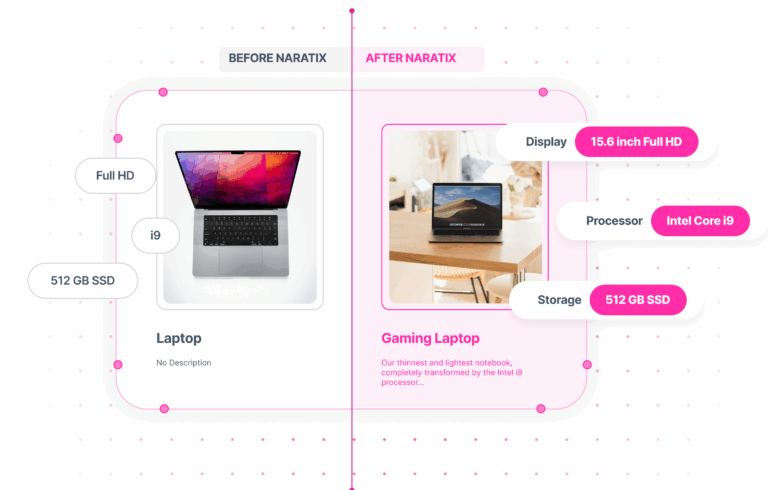Automate Hardware & Electronics Enrichment
Fill every spec, certify compatibility, and stay price-competitive so shoppers trust your tech catalog first

What is hardware catalog intelligence and how does it work?
Hardware catalog intelligence ingests supplier feeds, PDFs, and images, then completes chipsets, wattage, ports, certifications, and model-series data. It cleans photos, adds compliant image sets, and maps real-time price and stock shifts, delivering a ready-to-integrate catalog without touching live listings.
Hardware Catalog Intelligence Results
Tech SKUs enriched in 8 h
Verified spec-accuracy score
Faster channel go-live time
Why hardware catalog intelligence powers better catalog performance
Hardware catalog automation completes chipsets, wattage, ports, and certifications, refreshes images, and feeds live pricing insight so listings stay accurate, competitive, and conversion-ready across every channel.
Complete technical blueprints
Auto-fills chipsets, wattage, ports, OS, and certifications for every SKU
Compatibility confidence
Builds accessory & OS match tables to cut post-purchase returns
Marketplace-ready imagery
Cleans photos, adds angle shots, and meets Amazon & CE-mark DPI rules
Live price positioning
Tracks competitor pricing and promos to protect margin in real time
Faster model roll-outs
New series launch with accurate specs overnight, not in weeks
Lower return & RMA costs
Precise specs and visuals reduce buyer confusion and warranty claims
Ready to clean your tech catalog without expanding your team?
Request a free electronics sample and review the enriched data before you commit
Ecommerce automations by industry
Hardware catalog intelligence ingests supplier feeds, PDFs, and images, then completes chipsets, wattage, ports, certifications, and model-series data. It cleans photos, adds compliant image sets, and maps real-time price and stock shifts, delivering a ready-to-integrate catalog without touching live listings.
DIY
Fashion
General Marketplaces
Food & Beverages
Home & Deco
Industrial
Manufacturing
Automotive
Pharmaceutical
Beauty and Cosmetics
Sporting goods
Hardware Catalog Intelligence
What kinds of source files can we supply, and do they need to be fully structured?
You can upload CSV or XLSX feeds, XML or JSON API payloads, zipped folders of high-resolution images, and manufacturer PDFs in bulk via SFTP or direct cloud links. Even if half the columns are blank, the engine parses model numbers, partial EANs, and free-text “features” blocks, then cross-verifies them against vendor spec sheets, public databases, and our 50-million-SKU reference library. The result is a unified data lake from which accurate, standardised attributes are extracted and normalised.
How do you keep specifications accurate when models receive mid-cycle refreshes or silent part-number changes?
A delta-watcher monitors manufacturer change logs, FCC filings, and marketplace listing edits. When a chipset revision or firmware bump appears, affected SKUs are auto-requeued for micro-enrichment. The system reconciles new and old specs, flags any incompatibilities, such as a different wattage draw that might affect power-adapter bundles, and updates only the changed fields, preserving historical attributes for audit trails.
Can the platform generate and validate complex compatibility matrices, for example which motherboards accept a new CPU?
Yes. The rules engine ingests socket specs, BIOS versions, and chipset families, then builds bidirectional look-ups (CPU→board and board→CPU). Each matrix row carries a confidence score derived from manufacturer docs, benchmark databases, and crowd-sourced Q&A sites. During export, compatible accessory bundles can be auto-suggested, boosting basket size while minimising returns caused by mismatched parts.
What image enhancements are performed, and how do you meet strict marketplace photo policies?
Uploaded visuals undergo background removal, colour correction, and glare reduction. The system then generates additional angles, port call-outs, and comparison overlays using generative rendering tuned for CE device aesthetics. Final images are validated against Amazon, eBay, and Google requirements for DPI, aspect ratio, max file size, and no-text zones. Non-compliant files route to a remediation queue with suggested auto-crops and padding, ensuring every gallery passes first time.
How are competitor prices and stock levels tracked without manual URL lists?
A crawler network fingerprints each SKU via GTIN, MPN, and title vectors, then automatically discovers listings across 100+ global and regional electronics sites. Prices, promo badges, and stock badges are scraped hourly, deduplicated with probabilistic scoring, and surfaced in a dashboard that highlights under- or over-priced items relative to median market values. Alerts push to Slack or email when margins dip below your pre-set thresholds.
What processing time should we expect for an annual model refresh of 250 000 SKUs, and how is ongoing quality maintained?
A 250 K-SKU refresh, complete with new images, finishes in roughly 14 hours: ingestion (2 h), attribute extraction (6 h), visual QC and generation (4 h), price/stock mapping (1 h), and export & validation (≤1 h). After go-live, a nightly health monitor checks new supplier feeds for anomalies, missing part numbers, spec drift, or image failures, and schedules “nano-enrichment” jobs that patch only the affected SKUs, keeping your catalog pristine without repeating the full run.
Hardware catalog intelligence
Pricing is based on the volume and complexity of your operations. Get a personalized quote tailored to your product catalog size, automation needs, and platform requirements